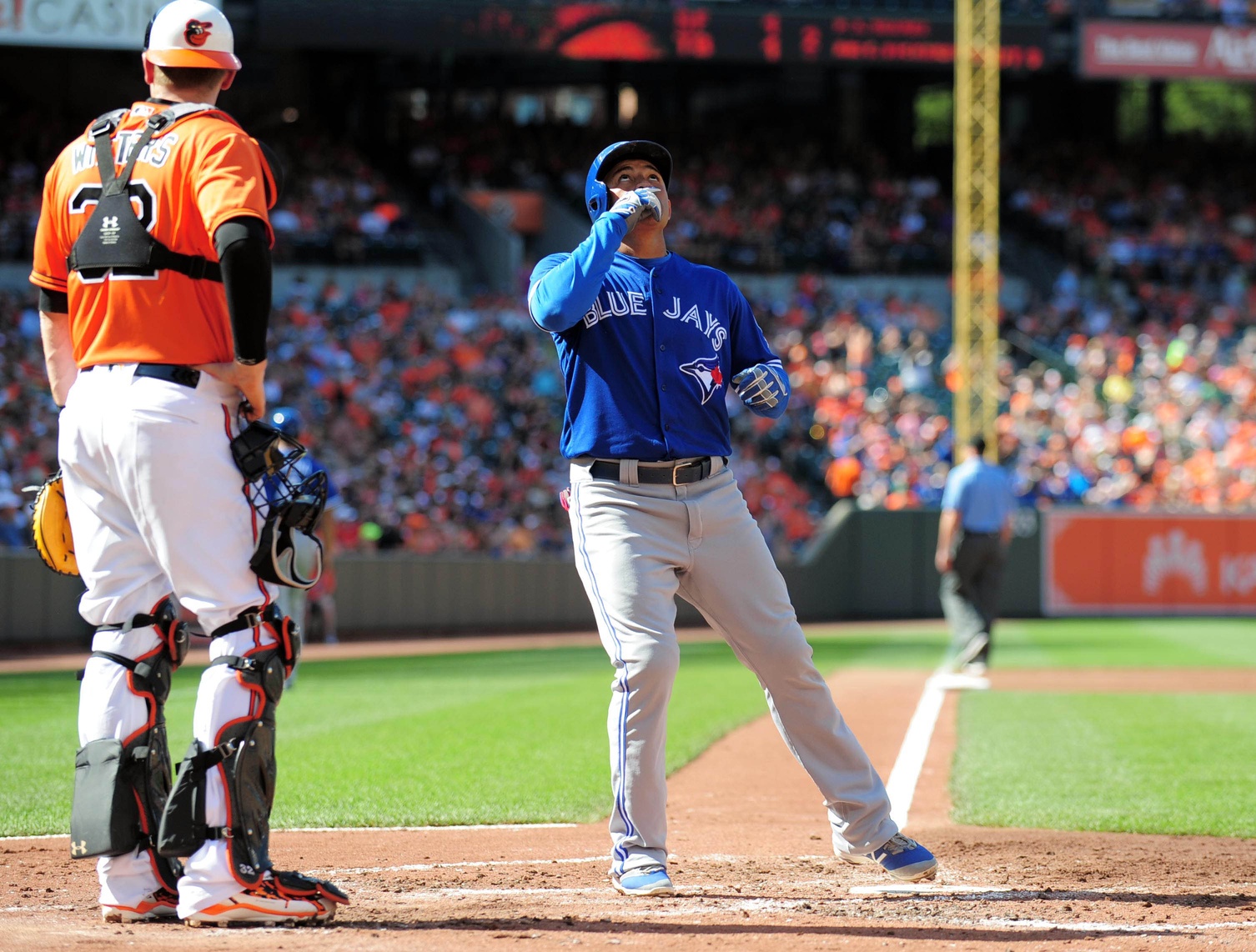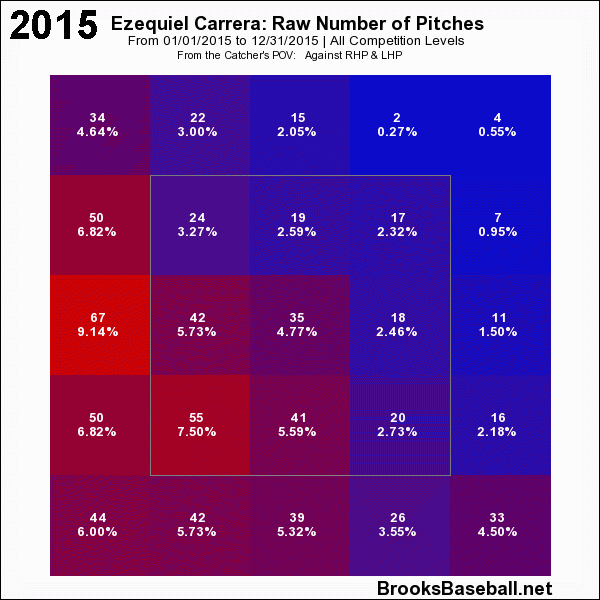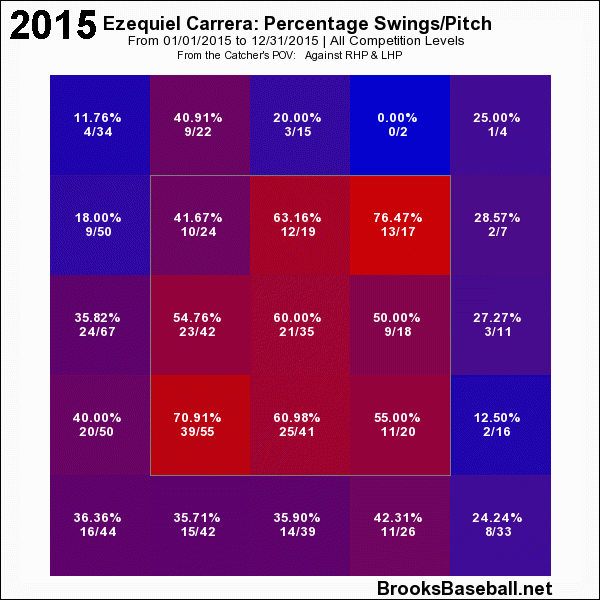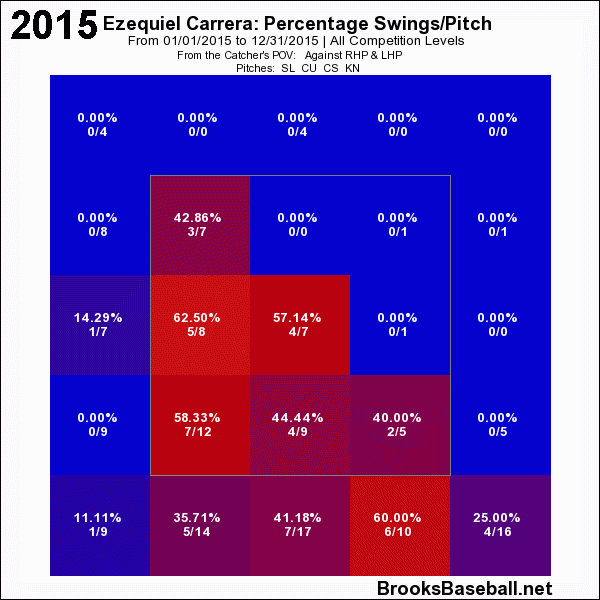The latest update on Jose Bautista’s injury wasn’t good. As the Toronto Sun put it, “Injured Jose Bautista not close to returning to Blue Jays“. For the most part, that’s not a good thing, but there has been one bright spot: Ezequiel Carrera. As the regular right fielder, he’s performed rather well, and now has a .275 TAv and 0.7 WARP on the season.
If you’d told me that at the beginning of the season he’d get consistent playing time, I’d have been very concerned. Heck, just two weeks ago, I vehemently dismissed his placement in the lineup. But with each additional game, the Ezequiel Carrera that is on a 2.7 WARP pace is looking increasingly real.
I’ll willingly admit that, in hindsight, the Carrera at leadoff comment was born out of ignorance. Having seen him play, and the gist of the sabermetric stat line, he looked no different than last year. He still has no power and has a regression-able BABIP.
However, as the sample sizes have increased, there’s a lot more to like when one takes a deeper statistical dive. So much so that he should probably be a starter, even after Jose Bautista comes back. Let me explain.
Of some importance: Zeke has crossed the threshold for walk rate and strikeout rate stabilization. At 10.1 percent, he’s posting a career best walk rate, and at 16.4 percent, he’s posting an incredibly improved strikeout rate.
Sometimes this happens because a hitter is getting pitched poorly. This is generally reflected in said hitter’s Zone%, which calculates the number of pitches that the hitter has received in the strike zone. That is not the case with Ezequiel Carrera, who, with a Zone% of 50.6%, is somewhat below his career average but at the same level as 2015. Ergo, it’s not a cause for concern. Here, you can see the lack of difference visually:
Carrera is getting more pitches low, but the same percentage in the zone versus 2015. What has changed is his swing selection, which you can see here:
There’s a lot more blue around the edges; Ezequiel Carrera is swinging at substantially fewer pitches outside the zone. At an outside swing rate of 21.4% in 2016, Zeke is 4.5 percentage points below his career average and 8.4 points below 2015. In fact, if you reduce the the minimum to 150 plate appearances, he has the 12th lowest outside swing rate in MLB. The result is the much improved strikeout and walk rates.
You may recall that another Blue Jay had a similar walk and strikeout rate improvement last season: Ryan Goins. In the month of August, as the regular second baseman, Ryan Goins put up a 18.6% walk rate; the third highest rate in baseball. Unfortunately, that “improvement” hasn’t shown up this season, and therefore it could be reasonable to question Carrera. However, there’s a rather important difference between the changes that the two players made. In the case of Goins, he stopped swinging altogether in the month of August. That worked at first, but later became a problem for him. Pitchers aren’t ignorant to the fact that Ryan Goins isn’t a very good hitter, and, in the months that proceeded, they threw him more pitches in the zone. His lack of hitting prowess made it difficult to adjust.
The difference with Carrera this season is that rather than not swinging at pitches altogether, he’s been selective. Namely, Zeke has shown an ability to recognize the low breaking balls, and lay off of them. Here’s his swing rate at breaking balls this year compared to last year:
In 2015, low breaking balls really hurt Ezequiel Carrera. In 2016, he hardly swings at them. In fact, he has gotten progressively better at laying off the breaking pitches each month. In April he swung at 36% of breaking balls; in May it was 31%; in June it was 13%.
Making contact has never been Carrera’s issue; he had been above average at that throughout his career. Instead, it’s been pitch selection. He always swung away at too many bad pitches, and gave up valuable on base points in the process. That’s not the case this season, as he has a .378 OBP.
Now here’s the kicker: when you couple together the pitch selection improvements with Ezequiel Carrera’s solid defense in left and right field, he could easily be an above average player this season. As was mentioned earlier, his current pace is for 2.7 WARP over 600 plate appearances; average is roughly 2.0 WARP.
The concern would be that pitchers will adjust to Zeke, and that it will hurt his results. My guess is that rather than testing him with breaking pitches, pitchers will try to overpower him with fastballs on the corners. Ezequiel Carrera doesn’t have very much power, but he can make contact. Opposing pitchers will have to be rather precise to beat him.
For the time being, that means very little in the way of managerial decisions, as he has no real competition outside of Junior Lake. But, once Jose Bautista comes back, the Jays will find themselves with four outfielders deserving playing time: Bautista, Carrera, Michael Saunders, and Kevin Pillar. Either Saunders or Carrera probably *could* play centre field, but they shouldn’t, so that position isn’t changing. That leaves two corner outfield spots for three players, which is actually a blessing in disguise.
As it stands, two of those three remaining outfielders are:
A. Horrid defenders.
B. At least somewhat brittle.
In fact, at their current paces, over a full season, Jose Bautista and Michael Saunders would be worth -15 runs and -10 runs on defense, respectively. That makes Bautista the second worst outfielder in MLB, and Saunders the 12th worst. Ergo, Carrera is a defensive upgrade over either. Concurrently, Justin Smoak has been a very poor offensive first baseman, and hasn’t performed particularly well on the defensive side either.
All of the above issues can be mitigated by reverting Smoak to a pinch-hitting role, and having Bautista and Saunders take over his time in the 1B/DH rotation. Both would play in the outfield, but would get more opportunities to rest their legs. In their place, splitting time between LF and RF, would be Ezequiel Carrera. Even if you call Carrera an average defender in the corner outfield spots (he’s likely better than that), that’s a marked improvement over Saunders and Bautista.
Will the Jays follow through with that plan? Possibly. Gibby has shown a willingness to get creative at times and this would certainly qualify. Another potential alternative is to put just Jose Bautista in Justin Smoak’s current spot, depending on the extent of his injury. If neither of those is the solution, then they’ll need to find something else. Ezequiel Carrera has established himself as a valuable piece of this Blue Jays’ outfield so far, and deserves the playing time. Of course, there’s always the possibility that the league adjusts to Carrera. But since Carrera is seeing the ball better and his improvements haven’t solely been based on an approach change, his success won’t go away quite as easily. He deserves a shot at being a full-time outfielder for the rest of the season, and the Jays have the opportunity to give it to him.
Lead Photo: Evan Habeeb-USA TODAY Sports




you are a moron. you know who can hit and who can’t. you were probably saying the same thing about edwin 5 years ago and about pillar being nothing but a AAA player. no such thing as babip helping you. do you even watch the games? carerra can hit he has talent. try watching the games instead of bashing everyone to make yourself look smart.
Huh?
I wrote a title and 1000 words lauding Ezequiel Carrera for the changes that he’s made to his pitch selection. Arguing that he can hit, and should be given a bigger chance at a full time spot.
Helps to read the entire piece.
I found the article thorough and informative. Some of the terms i dont know butdidnt stop me from liking the article.
Go Jays!
try reading the article instead of jumping straight to bashing the writer. In terms of making yourself look smart, that would work considerably better – well, maybe not smart, but less of a moron at least.
Nice job, Matt.
I wonder what you make of Carrera strange splits. As a left-handed hitter, you’d think he’d crush right handed pitchers, but no, he’s hitting .223/.348/.330 against them. It’s when he’s without the platoon advantage that he’s at his best (this year, since this is what the piece is primarily concerned with). Versus left-handers Carrera is hitting .422/.469/.533. Could be a BABIP issue (he’s got a .200 point swing between the two sides), but then I wonder what that says about any improvements he’s made.
I’d be interested to see how low power, contact-oriented lefties do in platoons splits (and will research this), because the typical left-on-left attack pattern (especially from relievers) seems like it would go to their strength, which is often shooting the ball the other way or up the middle.
Why do I feel like I’m about to learn things about Chong Figgins and Ben Revere that I never imagined would be important?
That’s actually exactly how I was planning to respond to this. That, and that Carrera has never really had any particular platoon splits, so reverse splits seem less concerning. And of course, there’s also the BABIP differential, as Matt mentioned.